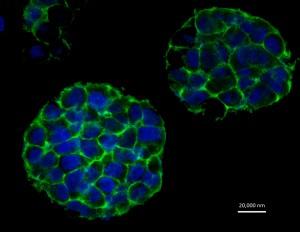There has been a tremendous amount of research being done on the 3D printing of living human cells to form bones, organs, and various other tissue. Such technology is certain to change the way the medical community  views regenerative medicine. There is another angle to this technology though, one in which 3D printing could end up being nearly as important to cancer research as it is to regenerative medicine.
views regenerative medicine. There is another angle to this technology though, one in which 3D printing could end up being nearly as important to cancer research as it is to regenerative medicine.
Researchers, led by Wei Sun, a professor in the department of mechanical engineering at Drexel University, in Philadelphia, as well as Singhua University, in China, have come up with a method of 3D printing cancer cells. They have done so, in such a way, that 90 percent of these cells survive and are able to be used in testing.
Currently billions of dollars a year are being spent on clinical trials, testing various drugs for any sign that they could help in the fight against cancer. There is a problem though. These tests use tiny, 2D, one layer thick structures of tumor cells, which allow researchers to test the various affects a drug can have on such a tumor. However, these 2D sheets are not ideal, since actual tumors are grown with not two, but three dimensions.
A 3D conglomerate of cancer cells should completely mimic that of an actual tumor found in a patient. This is where Wei Sun’s research has come into play. Sun was able to mix cervical cancer cells, with gelatin, and fibrous proteins, place them into a 3D printer,and layer by layer print out the sructure of a tumor. The cell structures were printed in a shape 10mm in length and width, and 2mm in height. After printing, he left the structures alone to grow for 8 days. As time passed they slowly formed into spherical balls of cells.
“With further understanding of these 3D models, we can use them to study the development, invasion, metastasis and treatment of cancer using specific cancer cells from patients. We can also use these models to test the efficacy and safety of new cancer treatment therapies and new cancer drugs,” said Sun.
The research being done here could potentially lead to more reliable testing of drugs, quicker FDA approval, and further understanding of how cancer cells replicate, as well as survive. The ability for researchers to have at their disposal a tomorrow of any shape or size, could one day lead to some pretty amazing discoveries, or even cures for the terrible disease. Discuss the latest on 3D printing of cancer cells, at 3dPrintboard.
(Header Image Source: : Zhao et al. Biofabrication)
(Results of study can be found at: iopscience.iop.org)
Subscribe to Our Email Newsletter
Stay up-to-date on all the latest news from the 3D printing industry and receive information and offers from third party vendors.
You May Also Like
AM Under Trump, First Thoughts: Reshoring
Constrained resources and the need to fight climate change have led to a new era of manufacturing focused on re- and nearshoring paired with supply chain resilience. In the battle...
3D Printing Webinar and Event Roundup: November 24, 2024
It’s a slow week for webinars and events in the 3D printing industry, whether because everyone is still tired from last week’s Formnext or it’s almost Thanksgiving here in the...
Formnext 2024 Roundup: Investments, Nickel-based Superalloys, & More
This week, more than 32,000 visitors will converge on Frankfurt to attend Formnext 2024, Europe’s leading additive manufacturing trade show. It started yesterday and goes until this Friday, November 22nd,...
EOS Launches New P3 NEXT SLS 3D Printer at Formnext 2004
EOS, the German-US leader in additive manufacturing (AM) solutions, has launched the P3 NEXT selective laser sintering (SLS) printer at Formnext 2024 in Frankfurt, Germany (November 19-22). EOS created the...




































